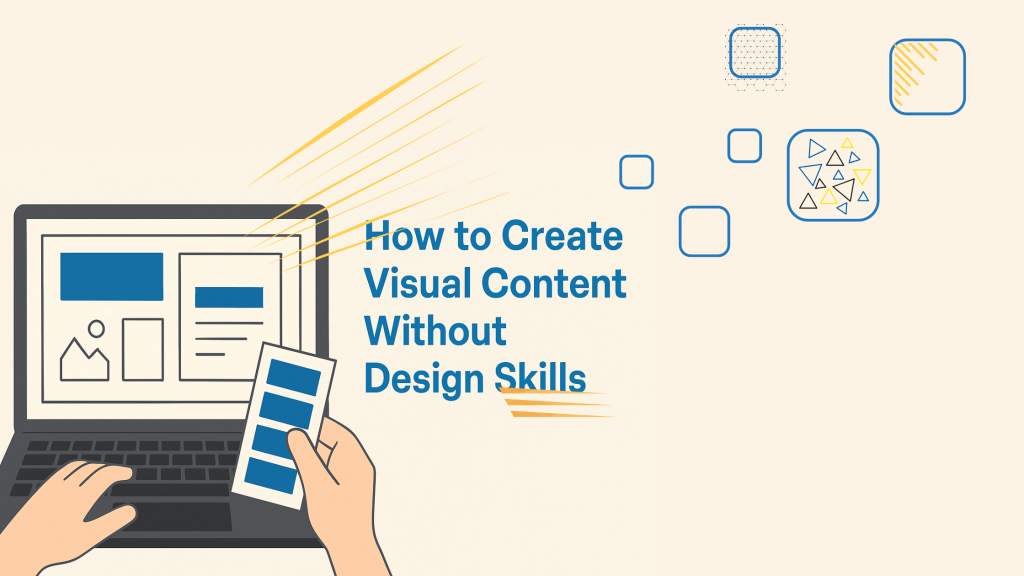
Visual content is a powerful way to grab attention and communicate ideas quickly. But not everyone has design skills. The good news? You don’t need to be a designer to create stunning visuals. With the right tools and simple techniques, you can make high-quality content for social media, blogs, and presentations. Here’s how:
1. Use Free Online Design Tools
Professional design software can be expensive and complicated. Instead, use free and easy-to-use tools.
Examples:
- Canva – Offers pre-made templates for social media posts, flyers, and presentations.
- Adobe Express – lets you create quick visuals with easy drag-and-drop features.
- Piktochart – Great for making infographics without needing design experience.
👉 Tip: Choose a template and customise colours, text, and images to match your brand.
2. Start with Templates
Templates make design simple. They are pre-designed layouts that you can edit to fit your needs.
Examples:
- Social Media Posts: Use Instagram post templates on Canva.
- Presentations: Try PowerPoint or Google Slides themes for a polished look.
- Infographics: Piktochart provides ready-to-use infographic designs.
👉 Tip: Pick a clean and professional template. Avoid too many colors and fonts.
3. Use Stock Images and Icons
You don’t need to take your own photos or draw graphics. Use high-quality stock images and icons.
Where to Find Them:
- Unsplash – Free high-resolution photos.
- Pexels – A large collection of stock images and videos.
- Flaticon – Download free icons for your designs.
👉 Tip: Choose images that match your message. Avoid overused or irrelevant stock photos.
4. Keep It Simple with Text and Fonts
Using too many fonts or complex text styles can make designs look messy. Stick to a few basic rules:
- Use two fonts max – One for headlines, one for body text.
- Make sure text is easy to read. Avoid overly decorative fonts.
- Keep the message short and clear.
Examples:
- Headline Font: Montserrat (Bold)
- Body Text: Open Sans (Regular)
👉 Tip: Canva and Google Fonts offer great free font options.
5. Use Colors Wisely
Colors affect how people feel about your content. Choose a color scheme that matches your brand or message.
How to Pick Colors:
- Use a color palette generator like Coolors.co.
- Follow the 60-30-10 rule – 60% main color, 30% secondary, 10% accent.
- Keep backgrounds light and text dark for readability.
Examples:
- A business post could use blue (trust) and white (clean).
- A food post could use warm colors like red and yellow to create an appetite appeal.
👉 Tip: Stick to 2-3 colors for a professional look.
6. Try Simple Animations
Animations make content more engaging. Even simple effects can boost visibility.
Easy Tools:
- Canva’s Animate feature – Adds motion to text and images.
- LottieFiles – Provides free animated icons.
- Kapwing – Helps you create short video clips and GIFs.
Examples:
- Add a subtle zoom effect to text.
- Use a moving arrow to guide attention to key points.
👉 Tip: Use animations sparingly. Too much movement can be distracting.
7. Turn Data into Infographics
Infographics simplify complex information and make it easier to understand.
How to Create:
- Use Piktochart, Canva, or Infogram.
- Keep data simple – Use icons and short text.
- Use charts and graphs instead of long paragraphs.
Example:
Instead of writing:
“70% of marketers say visuals improve engagement.”
Show a pie chart with 70% in bold and a simple caption.
👉 Tip: Stick to key facts and keep it visually clear.
8. Use Drag-and-Drop Video Editors
Video is more engaging than images alone. But editing software can be complicated. Use beginner-friendly tools instead.
Easy Video Editors:
- Canva Video – Drag-and-drop clips, text, and music.
- InShot – Great for quick mobile video edits.
Examples:
- Create short product videos with captions.
- Add subtitles to make videos more accessible.
👉 Tip: Keep videos short (15-30 seconds) for social media.
9. Use AI for Quick Designs
AI tools can help generate visuals fast, even if you have no design skills.
Examples:
- Canva’s Magic Design – Suggests design ideas based on your input.
- Remove.bg – Removes image backgrounds instantly.
- DALL·E – Creates unique AI-generated images.
👉 Tip: Use AI to get started, then tweak designs for a personal touch.
10. Practice and Keep Improving
The more you create, the better you get. Don’t be afraid to experiment.
Ways to Improve:
- Watch YouTube tutorials on Canva and free design tools.
- Follow design-focused Instagram pages for inspiration.
- Keep designs simple and clean—less is more.
Example:
Compare your old and new designs to see progress. Adjust based on what works best.
👉 Tip: Don’t overthink. Start with basic designs and improve over time.
Final Thoughts
Creating visual content without design skills is easier than ever. Use free tools, keep designs simple, and practice regularly. With time, you can create eye-catching content for any purpose.
Now, it’s your turn—pick a tool, try a design, and start creating! 🎨 🚀
